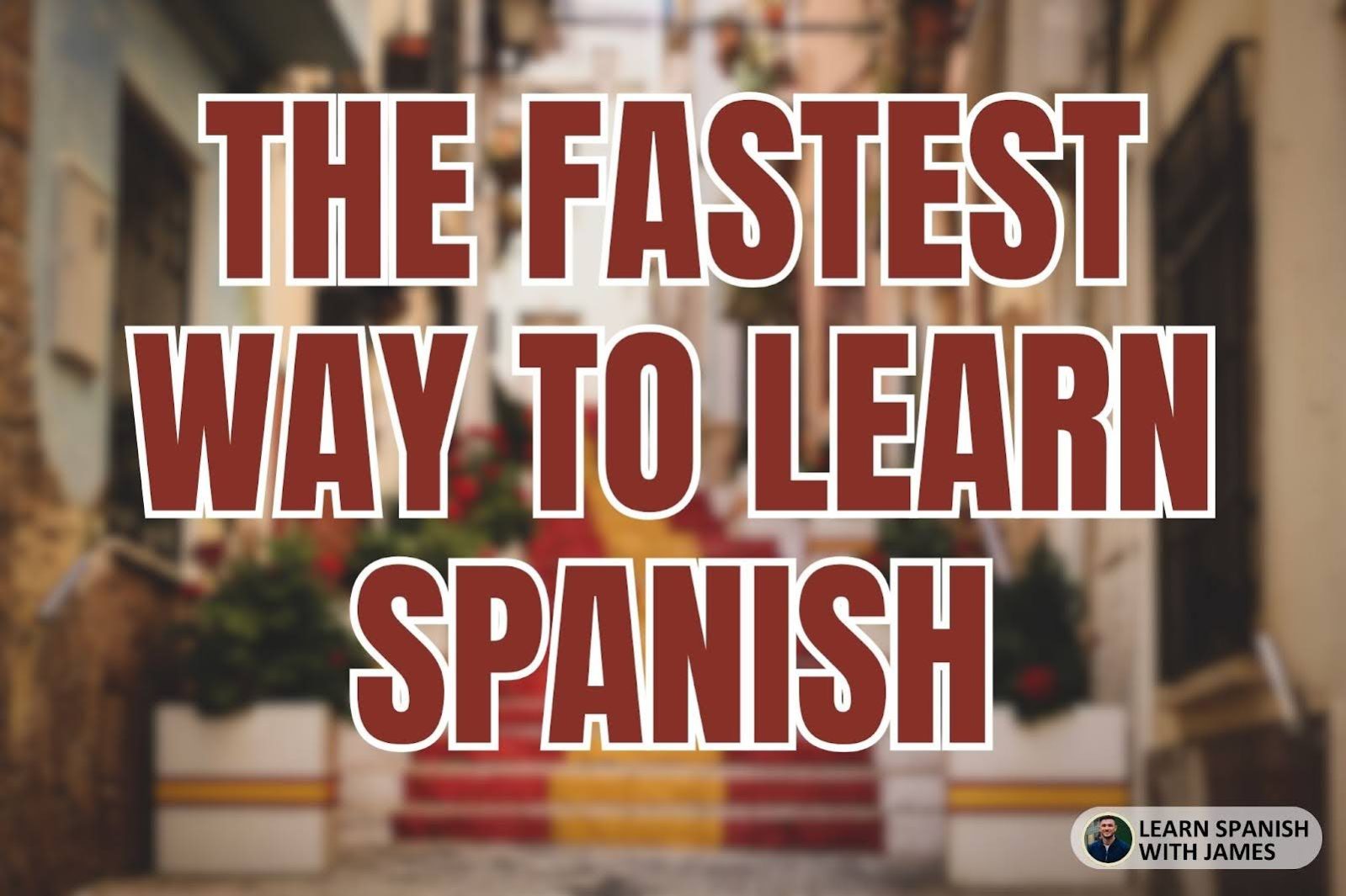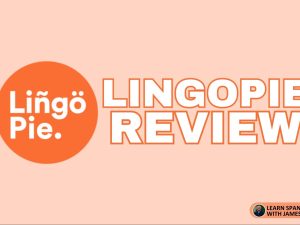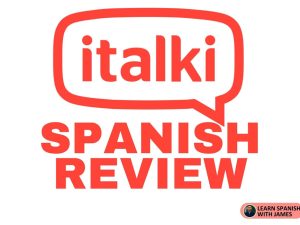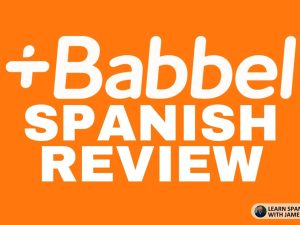The Fastest Way to Learn Spanish: Master Spanish Quickly

While learning a language in 30 days is not possible, (contrary to what many courses may promise) fast-tracking your Spanish fluency is.
By this, I mean that if you select the right method early on, it is possible to bypass the slow process often associated with language learning.
In this post, I’ll provide you with direct insights into the fastest ways to learn Spanish based on my personal experience going from zero to almost native fluency in Spanish.
I’m James, from Learn Spanish With James, and host of the Learn Spanish With James Podcast.
You’ll find all my techniques in this article, with no catch, and no costly programs.
Key Takeaways
👉 Embracing full immersion, having real conversations with native speakers, and integrating Spanish into everyday life proved more effective than relying solely on language apps for fluency.
👉 Creating a personal plan with specific goals, manageable milestones, and tailored learning schedules – while leveraging a mix of Spanish resources – accelerated the learning process.
👉 Cultural immersion is key, both physically by traveling to Spanish-speaking countries and virtually at home, along with overcoming the barrier of perfectionism through constant practice and self-recording.
From Zero to Fluent: A Breakdown of My Journey to Speak Spanish
My journey to master Spanish began with a desire to:
👉 Connect with people from different backgrounds
👉 Achieve quick progress and understand Spanish grammar rules
👉 Experience personal fulfilment by putting my progression into practice
👉 Speak Spanish fluently and sound like a native Spanish speaker
I craved the rewarding feeling of speaking Spanish fluently, even though I didn’t have the luxury of living in a Spanish-speaking country at first (I later moved to Argentina, then Costa Rica, and then Spain).
Initially, I leveraged a mix of immersive strategies and digital tools to learn Spanish quickly, and this is what you need to do if you want to achieve the same results.
I immersed myself in the language, interacted with native speakers, and integrated Spanish into my daily routines.
This meant tuning into Spanish radio daily, reading free news sources like El Pais online, and watching Spanish films whenever I could, even though I needed English subtitles initially.
Language learning apps were also my initial companions. However, I soon realized that apps could not replicate the confidence and proficiency gained through real-life conversations.
Active volunteering was also crucial; I worked at an office for a car rental company in Buenos Aires, and then for the same company at an airport in Costa Rica, a country where I also had a host family that spoke little English (which was great for my language progression).
Where and When I Saw the Most Progress
This all started at home, and at high school.
However, my progress skyrocketed when I visited Spain, Argentina, and Costa Rica.
There, I experienced the Spanish culture in its raw form and was exposed to the diverse accents, grammar, and vocabulary intrinsic to these regions.
Surprisingly, I found that speaking Spanish from the very first day was the key to my rapid progress.
👉 My key tip here: Do not shy away from speaking!
My Time in Spain, Argentina & Costa Rica
In Spain, Argentina, and Costa Rica, I was surrounded by Hispanic culture and the unique accents of each region. This took place over three years.
During this time I was working, not studying, so I didn’t even take part in online Spanish classes, or in-person classes.
However, surrounding myself with native Spanish speakers was invaluable. Doing so helped me understand how the language is used in real-life situations and navigate through various dialects.
Furthermore, I treated dating apps as opportunities to take individual classes.
This provided a personalized learning experience, far superior to group classes or night school. I thought of these dates as personal one-to-one speaking tuition!
Despite residing long-term in these countries, I traveled a lot as well.
And, as I traveled through these Spanish-speaking countries, I picked up regional vocabulary variations, like the different words for ‘bus’ in various countries:
- el autobús in Spain
- el colectivo in Argentina
- el camión in Mexico
- la guagua in the Dominican Republic
I was speaking to Native Spanish Speakers From Day One
As alluded to above, speaking Spanish right from the start was a game-changer.
In Argentina and Costa Rica, I was socializing with Spanish speakers every single day, both at home and at work.
Doing so meant constant practice speaking Spanish and the constant learning of new vocabulary. This real-life practice gave my Spanish learning journey a significant boost.
In addition to this, I focused on practical communication, studied Spanish grammar, made a study plan, listened to Latin music (something I still do daily), and remembered why I wanted to learn.
Have you ever listened to Nicky Jam or Daddy Yankee and understood their lyrics word for word? Trust me, it gives you a buzz! 🔥
In Buenos Aires, I went to plenty of language exchanges too, and these were of great help.
In case you’re unfamiliar with a language exchange, it’s a chance to be introduced to a Spanish speaker who wants to learn your language. So you speak Spanish, and they practice their English.
Language exchanges are great, as they allow you to teach and learn while providing the chance to practice Spanish in a casual, real-life setting.
1. Work – Don’t Study
If you are a student from the U.K or the U.S (or anywhere in the world that provides an opportunity to move to a Spanish-speaking country), I recommend you work instead of attend a university.
The social benefits of studying abroad are tremendous, but you’ll find yourself mixing with English speakers and speaking less Spanish than you should.
This was result in slower progression. Much slower progression, in fact.
Instead, you should try to find work in a Spanish-speaking environment.
I was fortunate to find work placements in Argentina and Costa Rica respectively. This catapulted my Spanish (in some cases) above those who had opted to study abroad in Europe.
Sure, they had a blast. But I had a blast and became totally immersed in the language, seven days per week.
2. Date in a Foreign Language
The benefits of dating Spanish-speakers when you’re learning Spanish really cannot be overstated. When we date, we drink 🍷🍷🍷 (some of us do, anyway).
And when we drink, we become more chatty, confident, and social. All three of these factors lead to conversational language progression.
I am no longer in a position to date. But when I could, I deliberately chose to meet with people I knew were unable to string a sentence together in English!
Why? It forced me to speak Spanish. If I didn’t, we’d have sat in silence for an hour and a half in an awkward staring contest.
If you’re not in a position to date, check out apps like Tandem for free language exchanges. Or, attend real, in-person language exchanges, which are even better.
3. Ditch Language Apps When You Reach Conversational Fluency
When I first started learning Spanish, I used Spanish apps every day. However, when I got to a conversational standard, I ditched them for real immersion.
Why? Well, I found that confidence and proficiency through real-life conversations and immersion in Spanish were unmatched by any app.
In honesty, this transition was a turning point in my Spanish learning journey.
Apps are addictive and fun, and we feel a sense of achievment when we get to that next level. But they don’t teach us to communicate with real people.
And for me, if I can’t communicate with real people, then there’s no point learning the language!
4. Create Your Own Spanish Study Plan
I’d love to tell you that creating a personalized Spanish mastery plan was the backbone of my language learning success.
I’d love to say I set specific goals, breaking them down into achievable milestones, and tailored my learning to fit my schedule.
But my brain doesn’t work that way. So, I didn’t.
Instead, I just enjoyed the journey and found the progression to come so much faster when I wasn’t putting pressure on myself.
Despite this, as a Spanish teacher, I know now that you can learn Spanish fast but adopting a study plan. Let’s explore how.
5. Understand Your Personal Aims
Recognizing your main objectives in language learning is important.
It helps you to focus on what is most important to learn and enables you to set goals based on your potential growth level.
When learning Spanish, it’s essential to set goals that cover:
👉 Listening: Get used to listening to spoken Spanish as quickly as possible, and embrace not being able to understand 90% of what you hear as a complete beginner.
👉 Speaking: Do not shy away from speaking Spanish, and accept you’ll make mistakes. Speaking from an early stage is the quickest way to reach conversational Spanish.
👉 Reading: Spanish is a phonetic language, which means reading from an early stage will help you with all other elements later down the line.
👉 Writing: Visual learners in particular can remember new vocabulary by writing words and Spanish phrases regularly. Try using Spanish flashcards for this.
If you’re someone who likes structure, aim to memorize some conversational phrases or learn a set number of new words each month.
6. Set Achievable Milestones
Establishing reachable milestones is the key to successful language learning.
It helps to:
👉 Break down long-term goals into manageable tasks
👉 Keep you motivated and on track
👉 Allow you to measure progress
👉 Help you focus on achieving smaller victories along the way
These milestones could be things like having a one-on-one conversation with a native speaker in their native language, being able to watch YouTube videos in the target language, and understanding unknown words from context.
7. Tailor Learning to Fit Your Schedule
Tailoring learning methods to accommodate your schedule is vital. To fit in Spanish learning effectively, I made it a priority by:
👉 Taking classes in a language school (before I swapped this for daily immersion with less academic study)
👉 Setting a daily routine for learning elements I found difficult, like Spanish gender, and new words and phrases linked to complex topics.
👉 Allocating specific time slots for language study or to focus on listening comprehension with podcasts
👉 Using spaced repetition systems for efficient studying and to boost conversational fluency
I made the learning process more manageable by focusing on one grammar concept at a time, mastering a set of vocabulary words, and practicing specific skills like listening or reading comprehension.
8. Diversify Your Learning Methods As Much As Possible
Integrating a variety of learning methods enriches the language learning experience. Here are some methods I used:
👉 Flashcards (great in particular for visual learners)
👉 Different language-learning apps (until I ditched them)
👉 Immersion in the culture (listening to the second language daily is the fastest way to master it)
👉 Creating a schedule for spaced repetition, even with basic vocabulary
👉 Setting my own goals, which usually focused on improving my speaking skills
If you want to get creative, you can try to create a themed dictionary, where you can put all the new words you come across.
Did I do this? No. But hey, it works for my students!
9. Don’t Hide from the Foundations of Spanish You MUST Learn
Mastering the foundations of Spanish, including Spanish grammar, vocabulary, and gender/articles, is a must for every Spanish learner.
10. Grasp Basic Grammar Early On
Understanding basic grammar at an early stage is vital. It helps with:
👉 Feeling more confident when expressing yourself
👉 Writing clearly
👉 Getting your point across
👉 Using punctuation correctly
👉 Understanding key concepts like gender (something alien to many)
I focused on reading blogs, watching videos, downloading learning apps, using flashcards, practicing with native speakers, taking online Spanish courses, and joining language exchange groups.
11. Prioritise High-Frequency Vocabulary
Emphasizing high-frequency vocabulary is key if you want to learn Spanish fast. These are the words that people use the most in the language:
- ‘estoy’ (from “estar“)
- ‘soy’
- ‘feliz’
- ‘gracias’
- ‘con’
- ‘gusta’
- ‘hay’
- ‘es’
- ‘tiene’ (from “tener“)
- ‘va’
- ‘le(s) gusta(n)’
- ‘qué’
- ‘mucho’
- ‘muy’
- ‘cómo’
By the way, the first two in that list can be game changers.
For a breakdown of how to use these verbs, check out my post on Ser Vs. Estar.
In order to practice these high-frequency Spanish words, I wrote the words often, used sentence stems for speaking practice, and focused on those high-frequency verbs to improve my communication skills quickly.
12. Understand the Role of Gender and Articles
Comprehending the role of gender and articles is essential to mastering a foreign language, but it’s particularly important in Spanish if you want to avoid sounding silly.
If you’re a complete beginner, this may sound daunting. Don’t let it scare you; just know that in Spanish, all nouns have a gender, and other words like articles and adjectives have to match the gender of the nouns they’re used with.
11. Prioritise Listening and Pronunciation
Prioritizing listening and pronunciation is key to mastering spoken Spanish.
I sharpened my ear without even thinking about it by working in an office full of Argentinians.
I listened to everything they’d say, from office chit chat to more professional client-facing meetings.
This was really tricky, especially at the start. But it meant that after several months, I could understand not only Argentine Spanish, but any other Spanish accent or dialect out there.
Not everyone gets to work in an office in a Spanish-speaking country.
But other ways you can do the same are to listen to authentic content on platforms like Lingopie and take part in interactive pronunciation practice on platforms like Lingoda.
12. Sharpen Your Ear with Authentic Content
Using authentic content will help you to sharpen your listening skills.
But what is authentic content? Well, authentic content in Spanish language learning is all about using materials that make you feel like you’re using the language in everyday situations.
I use YouTube for personalized videos, but there are plenty of other Spanish courses online that can help you access authentic material.
13. Master Spanish Sounds
Perfecting Spanish sounds for precise pronunciation is vital. In Spanish, there are some sounds like:
- c (like a ‘z’ in many parts of Spain)
- g (like our ‘h’ in some contexts)
- h (silent)
- j (like our ‘h’)
- ll (like our ‘y’)
- ñ (‘ny’)
- qu (like our ‘k’)
- r (‘rrr’
- v (like our ‘b’)
- z (like a ‘c’ in many parts of Spain)
This can be a bit challenging for English speakers. The sooner you start, the easier it becomes.
14. Take Part in Interactive Pronunciation Practice
Engaging in interactive pronunciation practice helped me improve my pronunciation.
Using exercises and printables, practicing tongue twisters, and shadowing were all effective for interactive pronunciation practice.
15. Build Confidence Through Practice
Building confidence in Spanish through practice and overcoming perfectionism was an integral part of my journey. I achieved this by:
👉 Overcoming the barrier of perfectionism (this applies to everything I do in life. Spanish pronunciation is no different)
👉 Learning how to engage in real conversations (Stop learning how to ask for an apple at the supermarket. Instead, learn how to ask if someone fancies meeting up for a beer!)
👉 Recording myself speaking Spanish to track progress and improvement. (This one was cringe as hell, but knowing how I sounded helped me get better).
Overcoming the Barrier of Perfectionism when Learning Spanish
Breaking free from the trap of perfectionism was significant for my language acquisition.
Being a perfectionist can slow down your progress in learning Spanish, especially when it comes to speaking. Here are some strategies that helped me:
👉 Focus on the process rather than the outcome
👉 Challenge perfectionistic thoughts
👉 Consider cognitive behavioral therapy (CBT)
👉 Become more aware of your thoughts and beliefs
By implementing these strategies, you can overcome perfectionism and make faster progress in learning Spanish.
How to Engage in Real Conversations
Participating in authentic conversations was instrumental in boosting my confidence in Spanish. Here are some strategies I used:
👉 Focused on vocabulary
👉 Practiced speaking
👉 Had a learning routine
👉 Immersed myself in Spanish
👉 Started speaking as soon as possible
👉 Wasn’t shy
👉 Practiced imaginary conversations
Recording Yourself (This Works – Trust Me)
Recording myself speaking Spanish played a significant role in tracking my progress and improvement.
When you record yourself speaking Spanish, it can help you improve your pronunciation, and fluency, and identify areas where you need to get better.
Cultural Immersion from Home
Immersing myself in Spanish culture from home through virtual experiences and following influential Spanish speakers was a game-changer for my Spanish learning journey.
Let’s examine how this cultural immersion took shape.
Discovering Spanish in Spain and Latin America
Discovering Spanish culture in Spain and Latin America from the comfort of my home was a key part of my journey and something that left me with no choice but to move to these places long-term.
The Spanish language in Spain and Latin America is influenced by the rich cultural diversity of the region, including indigenous and European influences.
Celebrating Hispanic Festivals Virtually
Celebrating Hispanic festivals virtually was a fun way for me to immerse myself in the Spanish culture.
I virtually celebrated popular Hispanic festivals like La Tomatina in Buñol, Las Fallas in Valencia, and Carnaval in different Latin American countries.
Following Influential Spanish Speakers – Check Out These Guys
Following influential Spanish speakers was a great way for me to immerse myself in the language and the culture.
I followed influential Spanish speakers like Juan Diego, Lissette Calveiro, and others to get insights into cultural norms and authentically learn the language.
Advanced Tactics for Language Learners
For those who have mastered the basics of Spanish, there are advanced tactics that can further augment your language skills, especially when interacting with native Spanish speakers.
Let’s look into these tactics.
Delving into Spanish Literature and Press
Reading literature in Spanish reinforced my understanding of new words by providing context clues.
I utilized resources like FluentU for personalized videos, Grahn for Lang for themed resources, and Spanish Academy’s ultimate resource list for beginners.
Exploring Regional Dialects and Idioms
Exploring regional dialects and idioms gave me a deeper understanding of Spanish.
The main regional dialects of Spanish include Castilian, Andalusian, Murcian, Llanito, Catalan, and Basque.
Then, when I got to Argentina, I wished people walked around with Spanish subtitles!
But I soon got used to the change.
Leveraging Technology for Language Drills
Leveraging technology for language drills and practice was a game-changer for me. I used the following tools:
- Duolingo: offers a variety of exercises for listening, speaking, reading, and writing in Spanish
- Evernote: helps with organizing and taking notes
- FluentU: provides resources like podcasts, audiobooks, and tools for language exchanges
These tools offered a variety of exercises and resources to improve my Spanish skills, including Spanish vocabulary.
Is it possible to learn Spanish in 2 months?
It’s possible to reach a basic conversational level in Spanish within 2 to 3 months, especially if your goal is to have enough knowledge for basic travel conversations.
What is the fastest way of learning Spanish?
The fastest way to learn Spanish is through immersion, which provides a constant stream of the language, allowing you to hear and read it all the time. It’s a highly effective method for language acquisition.
Final Thoughts
My journey to mastering Spanish quickly was an exciting one filled with personal fulfillment and an enriching cultural experience.
The strategies that worked best for me were:
👉 Dedicating time to writing in Spanish
👉 Immersing in the language by moving to Spain, Argentina, and Costa Rica
👉 Using structured online platforms and online courses
👉 Engaging in language exchanges and going on dates!
👉 Consuming authentic content from free online newspapers
👉 Integrating Spanish into my daily routine
👉 Listening to and translating Spanish music I liked
👉 Watching Telenovelas (painful, but necessary)
👉 Reading extensively (first non-fiction, then fiction)
This journey taught me the importance of enjoying the process, staying motivated, and exploring new cultures and ways of life through the Spanish language.
Mastering Spanish quickly is a journey filled with perseverance, practice, and passion.
Remember, it’s not about achieving perfection but rather about enjoying the process, staying motivated, and exploring new cultures through language.
Go out there, embrace the journey, and let the magic of Spanish open new doors for you.

About James – Or Should that be Santiago?
My name is James. I am a Brit with a love for the Spanish language. I have lived in Spain, Argentina, and Costa Rica, and I have been teaching Spanish for over a decade. This site will show you how to master the elements of Spanish grammar that often dishearten learners. I hope you enjoy the site and find it useful.
If you are interested in taking your Spanish to the next level, check out the Courses section for a full list of the Spanish courses I suggest. All reviews are based on my personal opinions.
![]()

![]()

![]()
![]()
![]()





